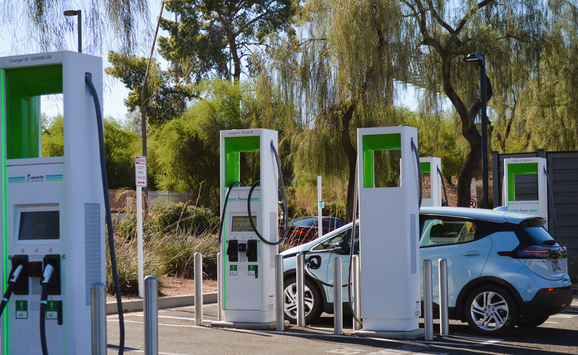Federal policy for the transportation sector will change with the new Trump administration—including what happens to the incentives and regulations related to increasing electric vehicle supply and demand. As a result, state governments may find themselves in the driver’s seat to effectively steer transportation policy toward decarbonization goals.
Demand for light-duty electric vehicles (EVs) has risen to about 10 percent of new vehicle sales nationwide, with California and a few other states far exceeding that average. Though part of this success has been due to improvements in EV manufacturing and quality, along with reduced battery costs, policies at the state and federal levels have played an important role. Effectively decarbonizing the transportation sector has relied on a whole-of-government approach, with various state and federal policies supporting one another to help move the needle toward increased EV adoption, particularly for passenger vehicles.
Given a recent decline in federal and monetary support for the EV transition, states will need to ramp up their own spending and strengthen their policies if they want to ensure continued advancement of EV adoption.
Three major types of policies have helped boost EV adoption to date: vehicle emissions standards, federal and state subsidies for vehicles and charging stations, and state-level EV mandates. These policies reinforce one another, working to simultaneously encourage EV manufacturing and increase demand by subsidizing vehicle purchases and expanding charging infrastructure. This policy complementarity means that weakening or removing one is likely to make the others less effective.
Resources for the Future (RFF) research has demonstrated that California’s EV mandate (the Advanced Clean Cars rule) helped the federal government increase the stringency of fuel efficiency standards. Without the mandate, manufacturers would have felt less pressure to make and sell EVs. Likewise, other RFF research has demonstrated that subsidies for public charging stations and EV purchases can reinforce one another in a positive feedback loop.

On January 20, 2025, President Donald Trump released an executive order titled Unleashing American Energy, which put a spotlight on actions that the administration may take to weaken vehicle electrification policies, potentially including the following:
- Halting the release of funds that were allocated in the Infrastructure Investment and Jobs Act for investments in charging stations through the National Electric Vehicle Infrastructure Formula Program and the Charging and Fueling Infrastructure Grant Program. Jointly, these programs represented an investment of $7.5 billion.
- Revisiting and loosening vehicle emissions standards, which had placed strong pressure on manufacturers to increase EV production.
- Eliminating the federal waiver that allowed California (and, subsequently, other states) to adopt an EV mandate.
Eliminating tax credits for EV purchases and battery manufacturing also may be in the works, though not included in recent executive orders. The tax credits would have cost the federal government $390 billion by 2028, according to estimates from the Massachusetts Institute of Technology—an order of magnitude larger than originally estimated by the Congressional Budget Office.
Cutting subsidies for public charging stations and certain EV purchases presumably would require congressional action, but the administration might try to weaken federal standards or revoke the waiver unilaterally. Already, the administration has moved forward on blocking the release of funds from the National Electric Vehicle Infrastructure Formula Program and temporarily paused the electric school bus subsidy program.
Reducing federal support creates a challenge for ensuring a robust supply of EVs and public charging stations nationwide.
These policy changes are likely to affect both the supply and demand of EVs. Automakers that have invested heavily in EVs may choose to stay committed, but some may scale back expansion plans or shift their focus to hybrid and gasoline vehicles, especially if demand declines. On the demand side, high-income consumers and fleets owned by large corporations like Amazon, which see EV investments as profitable, are likely to remain active in the EV market. However, price-sensitive buyers are more likely to delay EV adoption in the absence of federal incentives.
If Federal Policy Gets Scaled Back, Can States Act Independently to Achieve Their Own Goals for Electric Vehicle Adoption?
California has strong decarbonization goals for the transportation sector and has implemented a variety of policies that push forward EV adoption. In December 2024, California approved a $1.4-billion investment in charging stations statewide, which could replace the funds for infrastructure that would have come from the federal government. However, other states are fully reliant on federal funding. Given local budget shortfalls in California, and with its ongoing fire disasters, how much the state can afford to subsidize EVs remains an open question. Furthermore, California also has implemented its own emissions standards, which are part of the Advanced Clean Cars rule. However, if the waiver is rescinded, California (and others that followed the state’s lead) will no longer be able to set its own emissions requirements for vehicles.
Reducing federal support creates a challenge for ensuring a robust supply of EVs and public charging stations nationwide. Uncertainty about federal emissions standards and federal policies for EV charging hampers investment decisions for manufacturing, such as building new facilities for vehicle and battery production. Similarly, investors in charging stations will want some level of certainty regarding future demand so they can make informed investments. For states to achieve their goals, they will have to find policies that can provide some certainty for auto manufacturers and charging-station investors.

Moreover, states will be working against market forces. Vehicle manufacturers already have begun revisiting and scaling back their EV commitments. For example, General Motors in July 2024 backed out of its plan to manufacture a million EVs by the end of 2025. Similarly, the Alliance for Automotive Innovation penned a letter to Trump in November 2024, asking for a “stable and predictable regulatory environment” with standards that are “reasonable and achievable” and “aligned with current market realities.” The letter intimates a request for a reduction in stringency, given seemingly unfavorable market conditions. The slowdown in the growth rate of EV adoption in 2024 contributed to manufacturer concerns about the profitability of EV investments.
If States Can, Then How?
To meet ambitious goals that address climate change and EVs in the absence of federal support, state governments will have to revisit both the scope of their policies and the magnitude of their investments for transitioning to EVs. Given their limited resources, states will need to focus on finding the most cost-efficient policies to boost demand and to incentivize innovation and investment on the supply side.
For states with ambitious decarbonization goals and limited budgets, identifying and implementing policies that also maximize the broader benefits for economic and social well-being in the energy transition also would be valuable. (For more on that topic, see another article in this magazine issue about leveraging investments in EV charging stations to maximize public benefits.) Because public support for federal EV policy has waned over the years, a more decentralized policy approach may be viewed more favorably and would allow states to chart their own decarbonization pathways.
Given their limited resources, states will need to focus on finding the most cost-efficient policies to boost demand and to incentivize innovation and investment on the supply side.
Underlying these pending policy decisions, of course, is rigorous evidence. Timely research, including work that facilitates a better understanding of the barriers to EV adoption and how to overcome those barriers, can help guide states in identifying the most cost-effective suite of policies. One interesting example is the use of restructured registration fees to encourage electric truck adoption, as proposed by economist James Sallee. Understanding the price tag that’s involved for a state to achieve their EV goals without any federal support is an open question which also can benefit from more research.
Importantly, investments in EVs have broader implications above and beyond the fuel that powers the vehicle. Research has shown that growth in the EV fleet can drive job creation; for example, through an increase in EV manufacturing, a boost in battery manufacturing, and the workforce deployment required for the maintenance and operation of EVs and charging stations. Indeed, the letter to Trump from the Alliance for Automotive Innovation asked for the continuance of EV tax credits due to the benefits that have accrued in terms of increased manufacturing and job creation. Of course, reducing sales of new gasoline vehicles would reduce employment at certain production facilities and possibly for auto mechanics, as well. Thus, the effects on national and regional employment of slowing EV adoption still are unclear. Furthermore, charging stations placed in urban settings can have positive economic spillovers to neighboring businesses and can help improve outcomes such as affordability, accessibility, and broader economic growth for local communities if investments are made carefully.
Researchers at RFF will continue to track the quickly evolving world of federal and state policies in the EV space to provide relevant evidence of the trade-offs and possible outcomes for vehicle fleets among states and nationally.








